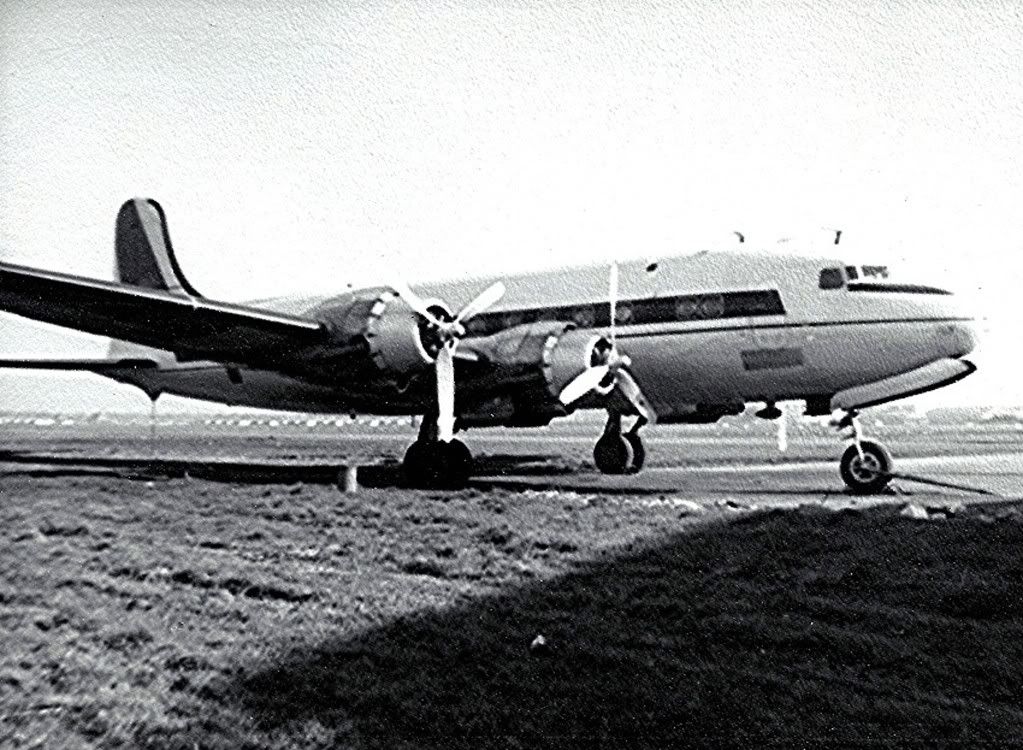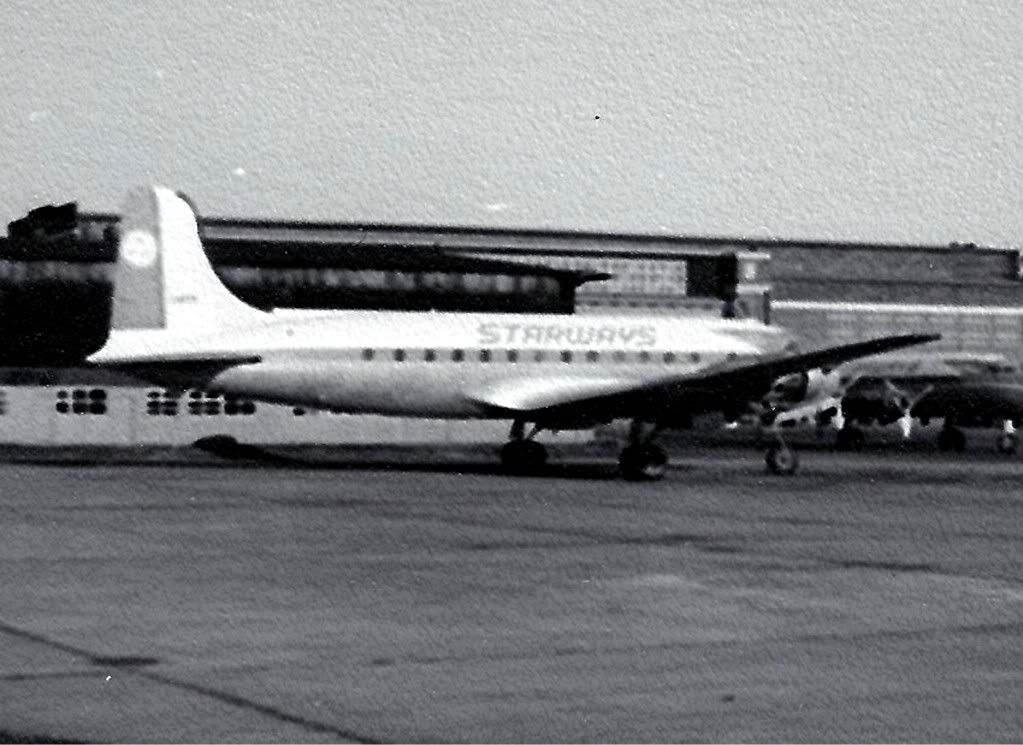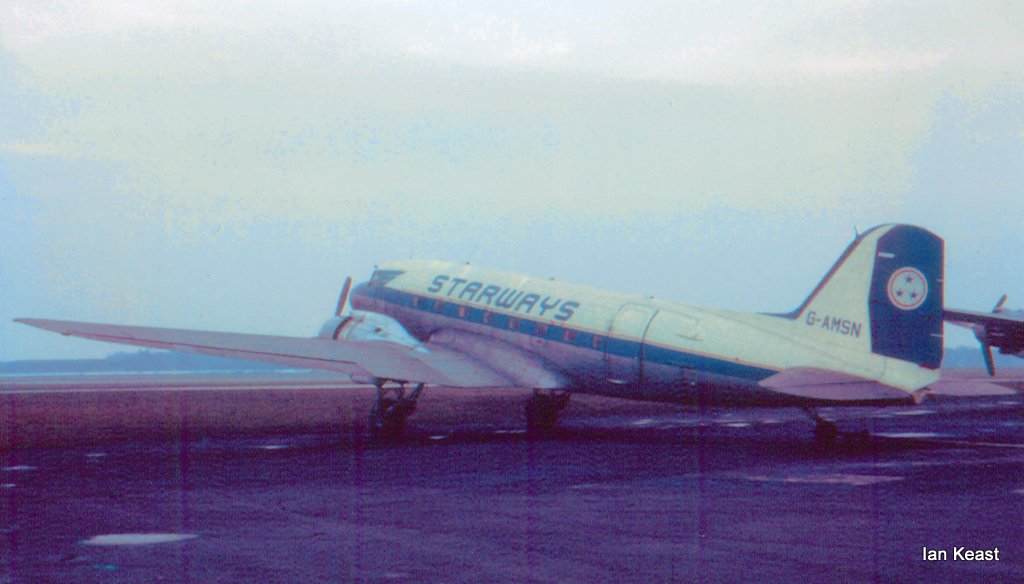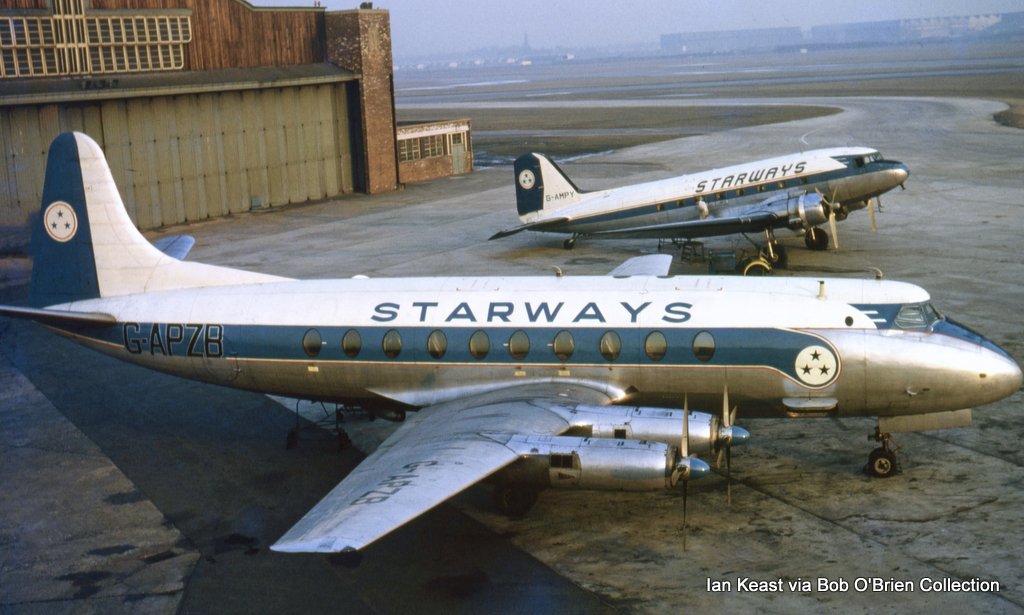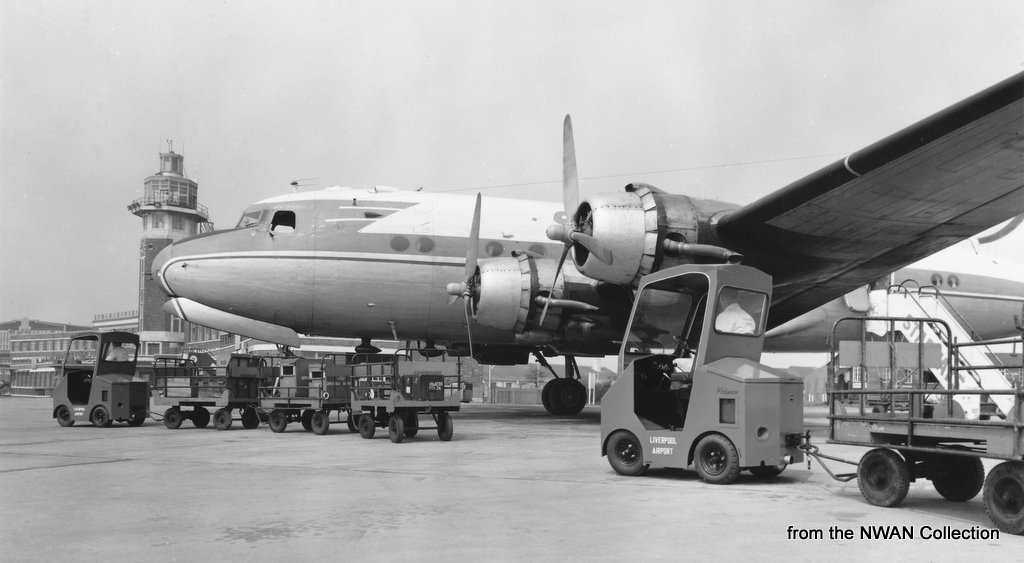Post by viscount on Jul 31, 2010 20:39:01 GMT 1
Starways Ltd
Aviation Overhauls Ltd
Trans-Meridian Ltd
Aviation Overhauls Ltd
Trans-Meridian Ltd
Probably the longest lived of the larger based operators and most nostalgically recalled of all the Liverpool based operators. The 'Starways' story was well told by Tony Merton-Jones in the 1976/77 four volume 'British Independent Airlines since 1946', published by TAHS/MAS, with great input by Phil Butler. Although there have been a number of summative articles since, this is the fullest, detailed account I'm aware of. Re-typed here in full with the absolute minimum of editing (mostly addition of sub-titles to aid readability on a screen, along with updated abbreviations and altered date presentation).
Do feel free to add photographs.
STARWAYS, 1948-1963
Foundation
Starways was founded late in 1948 to operate charter flights to and from Blackpool carrying show business personalities appearing in Blackpool shows. The company was registered as an airline company on 7th December 1948 by two pilots, Captain Noel Rodnight and Captain Albert Dean. The initial capital of Starways was £2000, and while Capt Rodnight became the company's Chief Pilot, Capt Dean took up the position of Company Secretary. Commercial operations began from Blackpool Airport in January 1949 with a Percival Q.6, but this aircraft was lost in an accident at Broomhall, Pwllheli, early in May 1949. Starways replaced this with an Avro Anson on lease, and at this time the company moved its base to Liverpool Airport.
Move to Liverpool and early charter operations
During 1949, Mr.F.H.Wilson and Mr.J.A.Wilson joined Starways as executives, and Mr.R.V.Baker joined the company as Operations and Commercial Manager. Starways undertook a variety of work at this time including Press work, newspaper and freight flights and army co-operation charters. At Liverpool Airport, the company established its main base including full maintenance facilities, and in 1950 subsidiary bases were set up at Walney Island (Barrow) and Northolt in support of the airline's operations from these aerodromes. One of Starways' major activities at this time was the operation of pleasure flights at Liverpool Airport, and throughout 1950 these flights were operated in competition with Airmotive. During the summer the Anson flew a service between Speke and Northolt.
In March 1950, two further Avro Ansons were acquired, and on 17th October Starways' first Douglas DC-3 entered service with the airline. This aircraft was placed into service on a freight run between Bovingdon and Belfast late in October, although still available for ad-hoc charter. One of the first ad-hoc charters to be flown by this aircraft was a passenger charter from the United Kingdom to Karachi on 14th November. On the return leg from Pakistan, G-AJDG collected 27 members of a ship's crew in Istanbul and flew them to Liverpool. One month later, on 20th December, the same aircraft was chartered to fly a group of Chinese seamen from Amsterdam to Liverpool. Throughout 1951, Starways' sole serviceable Douglas DC-3 was often chartered for the carriage of ships crews, on 5th February this aircraft operated a flight from Amsterdam to Newcastle and Prestwick carrying 28 seamen. On 24th March 1951, the Starways DC-3 began a three day tour of European cities with a party from a Midlands factory on board. Several capitals were visited including Amsterdam and Brussels. Shortly after its return from this charter, the DC-3 left Manchester for Toulouse early in April with a rugby team on board.
Freight and passenger charter work continue
In the spring of 1951, Starways' DC-3 opened a nightly service from Manchester Airport to Belfast carrying newspapers on behalf of a local newspaper distributor. Normally the aircraft returned empty from Belfast to Liverpool, but often the airline was able to arrange for a return load. The newspaper service to Belfast only continued for a short time, though, due to the crash of Air Transport Charter's C-47A Dakota, G-AJVZ, at Ringway on 27th March 1951. This aircraft had been chartered by Starways for just one service, but with the loss of the newspapers in the accident, Starways lost the newspaper contract itself.
During April and May 1951, the DC-3 was also chartered to make a number of flights between Amsterdam and Bovingdon carrying cargoes of lettuces. Other regular services flown by the company during 1951 included a weekly tour service from Liverpool to Tarbes, which was flown every Wednesday. On Saturdays, one of the Ansons plied its way from Liverpool to Jersey, with a stop en-route at Gatwick on both the outbound and inbound flights. The service to Tarbes and Jersey were only flown during the summer months by Starways. When the winer came the airline was forced to return to the operation of charter flights. Amongst the many flights undertaken by the DC-3 towards the end of the year were two charters from Marseillies to Palermo carrying ship's crew, and a service from Manchester to Marseilles carrying another rugby team.
Changes at the top and 1952 operations
During 1951, Mr.F.H.Wilson was appointed Chairman of the airline, while Captain Noel Rodnight retained his position as Chief Pilot. Mr.F.H.Wilson was a Liverpool businessman who owned the Famous Army Navy Stores and Limocoat Ltd (liverpool Motor Coat Company Ltd). Cathedral Touring Agency (CTA) was also owned by Mr. Wilson and this company provided Starways with all its early inclusive tour charter business. For 1951, over 200,000 miles were flown by Starways during the year, and five pilots were now employed by the company.
1952 began with a series of interesting charter flights, including one on 26th January carrying 19 members of a wrecked Greek steamer from West Hartlepool home to Athens. On its return flight from Greece, the DC-3 collected a further 20 seamen in Istanbul and flew them to Liverpool. Two weeks later, the DC-3 was used to transport 28 members of the Cornwall Rugby Football Union from Culdrose to La Baule, in Northern France. Throughout the summer of 1952, Starways ran its inclusive tour services from Liverpool to Jersey and Tarbes. In March five C-47 Dakotas were purchased from the Royal Air Force, although only three of these aircraft ever entered service with the company. During 1952, Starways' aircraft covered 220,000 miles, carrying a total of 4,800 passengers and a large amount of freight. Mr.J.M.Kent joined the company as Traffic Manager during the year.
Operations through the mid '50s
1953 began with one of the Dakotas carrying a consignment of flowers from Nice to Gothenburg, followed by the carriage of a ship's crew from Liverpool to Amsterdam on 6th February. For the 1953 season, Starways was granted its first scheduled service licence by the newly formed A.T.A.C. - this allowed the company to operate a full scheduled service from Liverpool to the Isle of Man. The airline also received permission to operate inclusive tour services from Liverpool to Bilbao and Tarbes, with both these routes being flown by the Dakotas throughout the 1953 summer season. By the end of the year, a total of 6.030 passengers and 274 tons of freight had been carried by the airline during the year.
In 1954, Messrs J.A. and F.H.Wilson acquired full control of Starways, and in June an inclusive tour service was added from Glasgow to Tarbes. This service was generally flown via Bournemouth or Jersey, while an inclusive tour route linking Liverpool with Nice was flown via Bournemouth. For the 1955 season, Starways flew A Belfast to Tarbes inclusive tour service on behalf of CTA, and a Liverpool to San Sebastian via Biarritz service. The most important new route opened by Starways during 1955 was a scheduled service linking Liverpool and London. This route was first flown by a Dakota in March 1955, and subsequently this was flown several times weekly throughout the year.
In May 1956, Starways opened a weekly Sunday inclusive tour service from Renfrew Airport, Glasgow to Jersey on behalf of Nugents Air Trips. During 1956, Starways continued to fly its services to Tarbes from Belfast, Glasgow and Liverpool, along with the flights to Biarritz and San Sebastian from Liverpool. While on a positioning flight from Liverpool to Renfrew/Glasgow on 28th March 1956 in preparation for a Lourdes/Tarbes flight the next morning, G-AMRB crashed into a hillside at Largs on a night approach, of the 3 occupants, there was 1 fatality.
In November 1956, Starways started airlifting Hungarian refugees from Austria to Blackbushe. The first Dakota to take part in this operation was given a formal send-off from Liverpool Liverpool by the Mayor of Liverpool, and altogether the company operated nine round trips carrying almost 300 people on this mini-airlift.
New aircraft and big expansion of inclusive tour charters
Services continued normally throughout 1957. In a major step forward, at the end of the year, Starways took delivery of its first Douglas Skymaster. After conversion, this aircraft, G-APEZ, entered service with the company when it carried a party of football fans from Liverpool to Southend in January 1958. A second Skymaster joined the company's fleet for the 1958 season, both of these aircraft were used on the ever expanding inclusive tour network to Europe. For the 1958 season, Starways operated scheduled routes from Liverpool to Heathrow, and from Glasgow to Jersey, while the inclusive tour charter network was rather more extensive. From Glasgow, the Skymasters and Dakotas flew holiday makers to Barcelona, Basle, Bergen, Bilbao, Palma, San Sebastian, Santander and Tarbes. Tarbes was also served by Starways from Belfast, Liverpool and Manchester. From Liverpool other holiday routes connected Merseyside with Basle, Bergen, Biarritz, Bilbao, Palma and Santander. A wide variety of long, medium and short range ad-hoc charters were flown by the company's fleet during the year. The company's executives now consisted of Mr.F.H.Wilson as Chairman, Mr.J.A.Wilson as Co-Director, Captain G.K.Leigh as Chief Pilot and Mr.J.M.Kent as Traffic Manager.
The 1959 season saw the introduction of an important new scheduled route linking Liverpool with the West Country. On 13th June, Skymaster G-APEZ, piloted by Capt Leigh, inaugurated a direct Liverpool to St.Mawgan service, which was subsequently flown on every weekend throughout the summer. In addition, on 27th June the company also introduced a Liverpool - Exeter - St.Mawgan service, which was also flown on Saturdays throughout the summer. The first service over this route was flown by Dakota G-AMPO with Capt Tickle in command.
For the 1959 season, Starways began a series of inclusive tour charter flights linking Manchester with Luxembourg, Palma, Perpignan and Pisa, these services being flown by both Skymasters and Dakotas. Many of the inclusive tour services from Glasgow were flown via Liverpool or Manchester in order to collect further passengers. Inclusive tour services were now operated from Blackpool, with the Skymasters carrying holidaymakers from Squire's Gate to Palma, Perpignan, Pisa and Tarbes throughout the 1959 and 1960 summer seasons. The winter months were normally quiet for Starways, and consequently the company's Skymasters were often leased out to other airlines. On 16th October 1959, G-APIN, left Liverpool, via Blackbushe, for Arabia to carry pilgrims to Mecca on behalf of Trans Arabian Airlines, with the Skymaster returning to Liverpool on 5th April 1960.
1960
With the success of its scheduled services to the West Country, Starways decided to open further services to Exeter and St.Mawgan from several other airports in the British Isles. Consequently, in June 1960 four new services to Exeter and St.Mawgan were opened from Birmingham, Glasgow, Manchester and Newcastle. The first routes to be opened were those from Birmingham and Glasgow, with Dakota G-AMSN operating a St.Mawgan - Birmingham - St.Mawgan service for the first time on the morning of Saturday 4th June. Also, on the same morning, G-AMPO opened the Glasgow to Exeter schedule, and a week later on Sunday 12th June G-AMPO flew the inaugural Newcastle to St.Mawgan. The fourth and final route to be opened was that linking Manchester with Exeter and St.Mawgan at midday on Sunday 19th June when G-AMPY lifted off Manchester's main runway bound for Exeter. Later services were also commenced linking Newquay (St.Mawgan) with Leeds and London, with the Leeds service being introduced as a stop on the Newcastle to Newquay schedule.
1960 also saw the introduction of a weekly flight from Liverpool to Ostend, flown on a Sunday afternoon by the Dakotas. The inaugural Liverpool to Ostend schedule was flown by Dakota G-AMPY on 12th June 1960 with Capt Feeman in command. Other destinations served from Liverpool included Biarritz (flown on Saturdays), Oporto (sundays), Perpignan (Saturdays), Santander (Tuesdays and Saturdays) and Tarbes (Mondays, Wednesdays and Saturdays). Holiday routes still connected the Mediterranean with Belfast, Glasgow and Manchester. During the year numerous charters were flown by Starways from Liverpool and Manchester. Amongst the many destinations served by Skymaster and Dakotas were Amsterdam, Antwerp, Bordeaux, Bremen, Frankfurt, Helsinki, Munich and Nantes.
On Wednesday 12th October 1960, Starways opened a scheduled service between Liverpool and Glasgow. The inaugural service was flown by Dakota G-AMPY piloted by Capt Tickle, with this aircraft lifting off Liverpool's main runway at 0829 in the morning. Subsequently, this route was flown twice daily in each direction on Tuesdays, Wednesdays and Thursdays. Later, Starways routed this service via Blackpool, and in November 1960 another new Dakota service was opened. This was a weekly freight service from Manchester to Prestwick flown on Sunday nights, with the first service being flown by Capt Dunsmore in G-AMPY on 20th November. This freight run, which was operated under charter, was only flown during the winter of 1960.
1960 saw several interesting applications being made to the A.T.A.C. by Starways. In March, the company asked for permission to open a vehicle-ferry service from Valley to Dublin using Bristol Freighter aircraft, but this route was never opened. In October 1960, Starways applied for permission to operate scheduled services from Hawarden to Dublin and Jersey, and include Hawarden as a traffic stop on many of its scheduled services from Liverpool. The first route to include Hawarden was the Liverpool to Heathrow service, but the first Liverpool - Hawarden - Heathrow was not flown until 1962.
1961 - Turboprops, inclusive tour expansion and loss of two aircraft
The 1961 inclusive tour programme was even more extensive from Liverpool than it had been in previous years, with the Skymasters and Dakotas flying tourists to Basle, Biarritz, Malaga, Munich, Oporto, Palma, Perpignan, Pisa, Rome, Santander and Tarbes. From Glasgow, Starways flew services to Oporto and Tarbes, while from Manchester only a weekly service was operated to Dinard every Friday by one of the Dakotas. On Sunday, 18th June 1961, Starways introduced a weekly scheduled Dakota service from Liverpool to Dinard.
In February 1961, Starways acquired its first turboprop equipment in the form of an Air France Viscount. After conversion, this aircraft entered service in May 1961 as G-ARIR, and throughout the summer was flown on many of Starways' scheduled and inclusive tour services. A draw back of the Viscount, was that at the height of summer, when loads were heavy, this Viscount flew many of its inclusive tour services to the Mediterranean via Gatwick or Bordeaux in order to refuel. The first scheduled service to be flown by the Viscount was the Liverpool to Heathrow service, and G-ARIR operated its first service over this route on the morning of Monday 12th June 1961, touching down on runway 28L at Heathrow at 0807. The acquisition of this Viscount released one of the Skymasters, G-APEZ, for lease to Sabena during the spring of 1961.
The Skymaster G-APEZ was followed by G-APYK and G-APIN, both of which also served with Sabena. These aircraft were used by the Belgian national airline in the Congo, under charter to the United Nations Organisation for much of 1961. G-APYK suffered a landing accident at Elizabethville 23rd July and was flown home to Prestwick for repair, being replaced in the Congo by G-APYK. However, two Skymasters were lost within days of each other at the end of the summer season. The first of these losses, G-APIN, was destroyed on the ground at Kamina Airport when it was attacked by a Katangan fighter aircraft. At the time this Skymaster was in use carrying troops around the Congo during the civil war, together with a number of other British owned aircraft. The second Starways Skymaster to be lost was G-ARJY when it overshoot the runway at Dublin while attempting to land. On board this aircraft were 69 passengers and a crew of 4, none of whom were seriously injured. While inbound to Dublin from Tarbes, the Skymaster was making a normal approach to Collinstown Airport when it suddenly swung to the left and skidded along the ground. After narrowly missing the terminal buildings, the Skymaster came to rest on a busy main road just outside the airport boundary. Although the aircraft did not catch fire, it was so badly damaged that it was declared to be a write-off.
Throughout 1961, Starways spent much of its time battling with the A.T.L.B. for permission to open a variety of new routes. In March, an application was made to open scheduled services from Hawarden to Belfast, Jersey and Ronaldsway. In May, the company applied for an economy and skycoach service from Glasgow, Liverpool and Manchester to Gibraltar, Bathurst, Freetown, Accra and Lagos using Jersey, Bordeaux and Las Palmas as technical stops en-route. However, Starways only received permission to open the Hawarden to Isle of Man route, with all the other applications being refused by the Board.
New Routes in 1962
While 1961 had seen several adventures overtaking the Skymasters and many other notable events taking place, 1962 saw the introduction of several important new routes. On 2nd April 1962, the airline opened a daily Liverpool - Hawarden -Heathrow scheduled service, followed on 19th May by the addition of Blackpool as a traffic stop on the Liverpool to Glasgow service. On 1st June, Starways opened a thrice weekly Liverpool to Cork scheduled service, and on the following day Viscount G-ARIR re-opened the weekly Glasgow to Exeter service, and on the same day a direct Edinburgh to Exeter service was inaugurated. The 1962 inclusive tour programme was restricted to departures from Glasgow, Liverpool and Manchester, and was flown almost entirely at weekends, At the end of 1962, a former Tradair Viscount, G-APZB, joined the Starways' fleet, and by the time that the 1963 seasons had begun, another Skymaster had also been acquired.
1963
The 1963 inclusive tour programme included departures from Liverpool to Albenga (Italy), Barcelona, Basle, Dinard, Nantes, Ostend, Palma, Perpignan and Tarbes. From Manchester, Starways' Skymasters and Viscounts flew holidaymakers to Basle, Nice, Palma, Perpignan and Pisa, while from Glasgow services were still flown to Tarbes. Having sold Skymaster G-APYK in February, at the height of the summer season, the company ran extra services necessitating the lease-in of further Skymasters. These aircraft included Lloyd International's G-ARWI used during July 1963, and Malta Metropolitan's VP-MAA used for a Palma to Liverpool service on the morning of 3rd August.
Amongst the many pilots who flew for Starways at this time were Captains Feenan, Goodwin, Hammond, Honeyman, Leigh, Monkton, Morgan, Potts, Royes, Tickle and Tracy. The Board of Directors and senior executives of Starways consisted of F.H.Wilson (Chairman), J.A.Wilson, A.M.Wilson, Captain G.K.Leigh (Chief Pilot), G.C.Gates and B.C.L.Johnson (Commercial Manager).
Merger Plans
On 19th November 1963, Starways signed an initial co-operation agreement with British Eagle International Airlines. Operations continued unchanged though, and during the winter months the company only ran the schedules from Liverpool to Glasgow and Heathrow.
On 31st December, Starways ceased operations, and on the morning of 1st January 1964, British Eagle took over all the former Starways routes. The Skymasters, Dakotas and one remaining Viscount remained in the ownership of the Starways' directors and did not pass into British Eagle ownership.
The last day of operations
The last day of Starways operations, therefore was 31st December 1963, and by this time only two aircraft were still flying for the company. The final Skymaster flight having been made by G-ARIY on the evening of 23rd December when Capt Goodwin piloted this aircraft on the Liverpool - Heathrow - Hawarden - Liverpool scheduled service.
The last day began shortly after 0800 in the morning when Capt Tickle lifted Viscount G-APZB into the frosty morning air above Liverpool en-route to Hawarden and Heathrow. Ten minutes later, the roar of Sierra November's two Twin Wasps was heard once more as Capt Goodwin opened the throttles for the penultimate Liverpool - Blackpool - Glasgow service. The Viscount returned to Speke again shortly before 1100, and operated another, this one direct, Liverpool to London service at midday. The Dakota returned from Glasgow late in the morning. During the afternoon the Viscount and Dakota flew Starways' final scheduled services. At 1733 G-AMSN took off from Liverpool piloted by Capt Goodwin, and after stopping off at Blackpool, this aircraft touched down at Renfrew at 1924 to complete the last Starways Dakota service. The Viscount left Liverpool at 1736 with Capt Tickle in command, and one hour later touched down at Heathrow. After a swift turn-around, the Viscount was airborne again en-route for Hawarden and Liverpool on the final Starways service. At 2010, Captain Tickle gently lowered G-APZB onto Speke's main runway marking the completion of fifteen years of flying by Starways.
During 1963, Starways had carried a total of 153,209 passengers, of which 6,837 were carried on international scheduled services, 114,196 on domestic scheduled services, with the remainder on inclusive and other charters. The utilisation of the fleet, though, was relatively low, with the Viscounts recording an annual utilisation of 1,238 hours, the Dakotas 1,157 hours and the Skymasters only 968 hours.
On 1st January, 1964, Starways' schedules were re-opened by British Eagle's Viscounts G-AMOC and G-AOCC, along with Britannia G-AOVT. Initially some of the Viscounts carried 'Starways' titles on an otherwise standard British Eagle scheme. On 1st September 1964, Starways officially changed its name to British Eagle (Liverpool) Ltd.









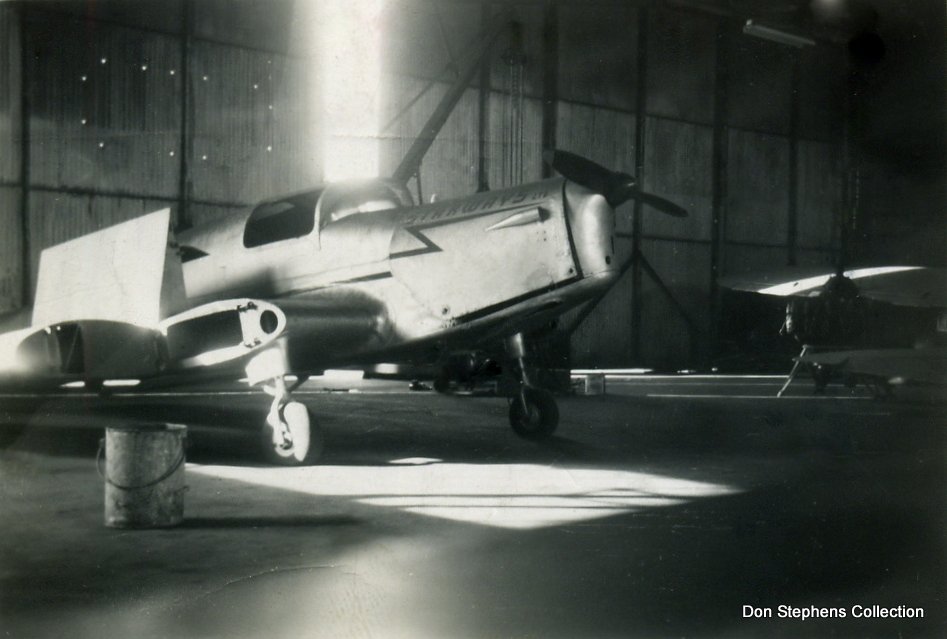








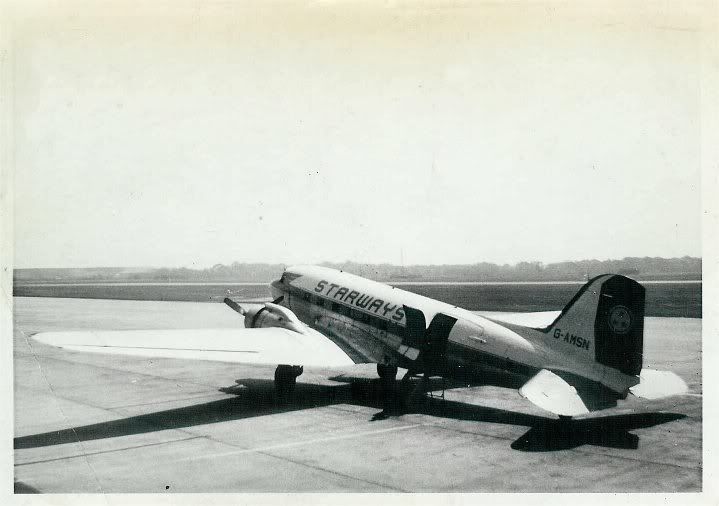
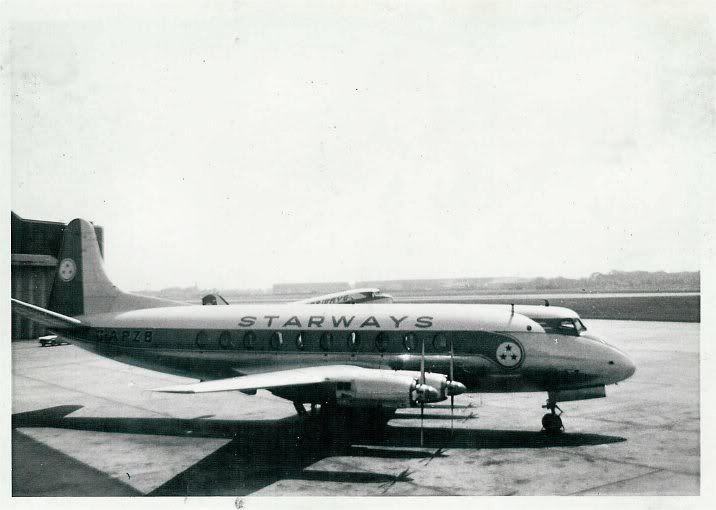
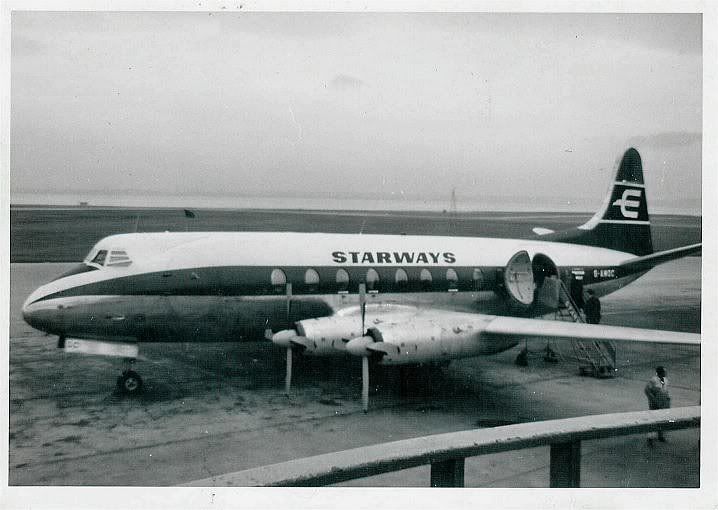
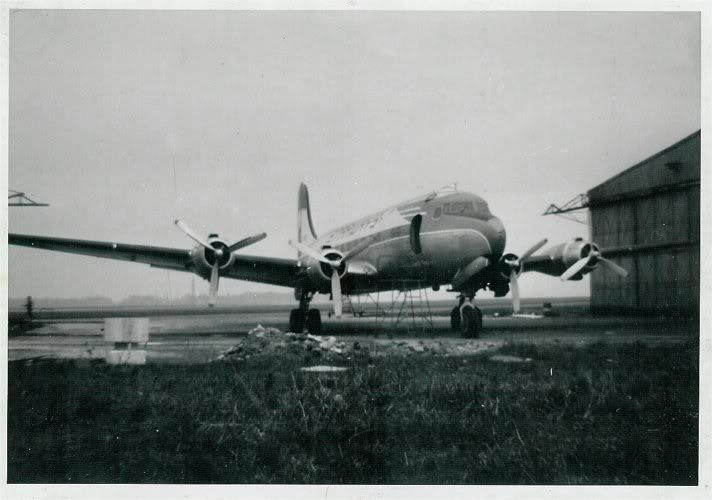














 (image showing)
(image showing) (image showing)
(image showing)

